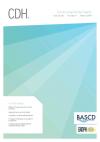Community Dental Health

- Cover Date:
- March 2019
- Print ISSN:
- 0265 539X
- Electronic ISSN:
- 2515-1746
- Vol:
- 36
- Issue:
- 1
Editorial:‘No simple solutions, no single ingredient’: Systemsorientated approaches for addressing Wicked Problems in population oral health
doi:10.1922/CDH_BakerMarch19editorial02
A Wicked Problem is a problem that is impossible or difficult
to solve partly because of its multi-component nature and its
interconnection with other problems (Rittel & Webber, 1973).
There are many Wicked Problems in the field of population
oral health; tooth decay being one. Tooth decay is a function
of biology (destruction of our tooth enamel); a function of our
physical environment (availability, advertising and accessibility
of sugar sweetened foods and drinks, availability of dental
services); a function of our social environment (norms of oral
hygiene and sugar consumption vary by socio-economic strata,
country, and cultures); a function of us as individuals (dietary
habits, visiting the dentist, oral health beliefs, toothbrushing,
use of fluoride, dental anxiety, income); and a function of
politics (our city, region and national policies on oral health
education, tax on sugar sweetened drinks, water fluoridation,
dental payment systems). The ‘Wicked Problem of tooth
decay’ therefore involves multiple factors, none of which
occurs in a vacuum. There therefore seems little point then in
studying them in a vacuum or intervening in a vacuum. Yet,
we continue to do so.
- Article Price
- £15.00
- Institution Article Price
- £
- Page Start
- 3
- Page End
- 4
- Authors
- Sarah R Baker
Articles from this issue
- Title
- Pg. Start
- Pg. End
- Editorial:‘No simple solutions, no single ingredient’: Systemsorientated approaches for addressing Wicked Problems in population oral health
- 3
- 4
- Dental Public Health in Action: The use of the NICE ten step model to conduct an oral health needs assessment in South Yorkshire and Bassetlaw
- 5
- 8
- Caries-preventive efficacy of a supervised school toothbrushing programme in Northland, New Zealand
- 9
- 16
- Socioeconomic Variation in the association between Malocclusion and Oral Health Related Quality of Life
- 17
- 21
- Low rates of dental attendance by the age of one and inequality between local government administrative areas in England
- 22
- 26
- The relationship between body mass index and oral health status among Saudi adults: a cross-sectional study
- 27
- 32
- The acceptability of fluoride varnish and fissure sealant treatments in children aged 6-9 delivered in a school setting
- 33
- 38
- Interventions to reduce socio-economic inequalities in dental service utilisation – a systematic review
- 39
- 45
- The Boundaries between Caries and Periodontal Diseases. What are the Implications for Education in Dental Public Health? Proceedings of EADPH/SESPO Pre-Congress Workshop held on Wednesday, 17 October 2018 at The Centro Cultural Sa Nostra Congress Cen
- 63
- 86
